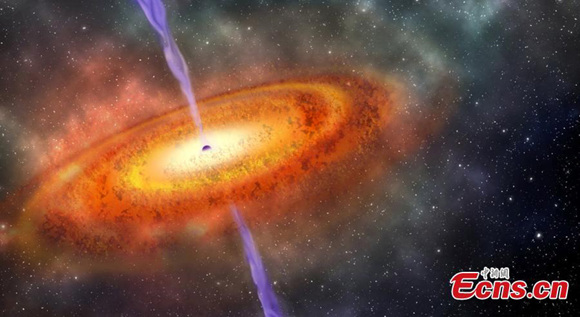
An artist's conception of the most-distant and oldest supermassive black hole ever discovered .The black hole resides in a quasar and its light had been traveling for 13 billion years before reaching Earth. It's a truly gargantuan black hole, some 800 million times the mass of our sun. The size amazed and puzzled astronomers, according to reports. (Photo/Agencies)
Astronomers have uncovered the farthest known supermassive black hole, which is 800 million times the mass of our Sun.
"This black hole grew far larger than we expected in only 690 million years after the Big Bang, which challenges our theories about how black holes form," study co-author Daniel Stern from NASA's Jet Propulsion Laboratory in Pasadena, California said in a news release.
Astronomers combined data from NASA's Wide-field Infrared Survey Explorer (WISE) with ground-based surveys to identify potential distant objects to study, then followed up with Carnegie Observatories' Magellan telescopes in Chile.
Carnegie astronomer Eduardo Banados led the effort to identify candidates out of the hundreds of millions of objects WISE found that would be worth following up with Magellan.
The newly found black hole, detailed in a paper published online in the journal Nature Wednesday, is positioned at the center of a galaxy, a phenomenon called a quasar.
This quasar is especially interesting because it comes from a time when the universe was just beginning to emerge from its dark ages. The discovery will provide fundamental information about the universe when it was only 5 percent of its current age, according to the study.
The quasar's distance is determined by what is called its redshift, a measurement of how much the wave-length of its light is stretched by the expansion of the universe before reaching Earth. The higher the redshift, the greater the distance, and the farther back astronomers are looking in time when they observe the object.
This newly discovered quasar has a redshift of 7.54, based on the detection of ionized carbon emissions from the galaxy that hosts the massive black hole. That means the quasar's light traveled some 13 billion light-years before reaching the Magellan telescopes.
"Quasars are among the brightest and most distant known celestial objects and are crucial to understand the early universe," said co-author Bram Venemans of the Max Planck Institute for Astronomy in Germany.
Scientists estimate that the sky contains 20 to 100 quasars which are as bright and distant as this quasar. However, the newly discovered one is not only the most distant, but also the only example we have that can be seen before the universe became reionized.
"It was the universe's last major transition and one of the current frontiers of astrophysics," Banados said.
In the coming years, astronomers hope to find more. "With several next-generation, even-more-sensitive facilities currently being built, we can expect many exciting discoveries in the very early universe in the coming years," Stern said.


















































